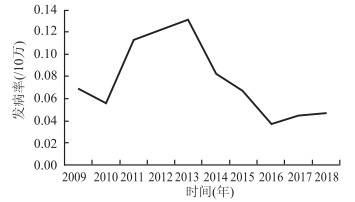-
摘要:
目的 分析陕西省1955-2017年狂犬病流行情况及第三流行期流行特征,为科学防控狂犬病提供依据。 方法 收集1953-2003年历史疫情资料、2004-2017年中国疾病预防控制信息系统狂犬病监测资料及2009-2017年狂犬病患者个案调查资料进行统计分析。 结果 1953-2017年,陕西省出现3次人间狂犬病流行。2009-2017年报告人狂犬病病例270例,每月均有狂犬病病例发生。病例主要集中在关中和陕南地区,陕北地区偶有病例报告。男女性别比为2.5:1,职业构成以农民为主(84.4%)。伤人犬中家养犬和流浪犬的构成比为13.1:1,家养犬伤人多发生在农村地区(86.9%)。暴露级别以Ⅲ级为主(84.2%)。超六成病例在伤后未对伤口进行任何处理,狂犬疫苗接种率和免疫球蛋白使用率均较低。 结论 民众对狂犬病的危害认识不足,致伤害后处理不规范甚至不处理,从而引起发病。应加大狂犬病防控知识宣传,并将重点放在农村偏远地区,倡导民众伤后主动就医病合理利用报销政策。 Abstract:Objective To analyze the epidemiological characteristics of rabies in 1955-2016 and the third epidemic period in shaanxi province, and to provide scientific basis for prevention and control of rabies. Methods The historical epidemic data from 1853 to 2003, the rabies surveillance data from Chinese diesase prevention and control information system from 2004 to 2017, and the rabies patient case survey data from 2009 to 2017 were collected to conduct the analysis. Results From 1953 to 2017, there were three epidemics of human rabies in Shaanxi Province. In 2009-2017, 270 cases of rabies were reported, and rabies cases occurred every month. Cases were mainly concentrated in Guanzhong and southern Shaanxi, and occasional cases were reported in northern Shaanxi. The male-female ratio is 2.51:1, and the occupational composition was dominated by farmers (84.4%). Injured dogs were mainly domesticated dogs, the ratio of domestic and stray dogs was 13.07:1. The exposure level was mainly grade Ⅲ (84.23%). The wounds of 60% cases were not treated after the injury, and the rabies vaccination rate and immunoglobulin utilization rate were both low. Conclusions The public's awareness of the dangers of rabies was still insufficient, so that there was no standard treatment after canine bite, which causes disease. It is necessary to increase the publicity of rabies prevention and control knowledge. The focus should be placed on remote areas and rural areas, and the public should be advocated to take the initiative to use the reimbursement policy for medical treatment. -
Key words:
- Rabies /
- Epidemiological characteristics /
- Shaanxi province
-
表 1 2009-2017年陕西省狂犬病病例暴露后处置情况[n(%)]
Table 1. Post-exposure treatment of rabies cases in Shaanxi Province from 2009 to 2017[n(%)]
时间 伤口规范处置 接种狂犬疫苗 使用人狂犬病免疫球蛋白 2009年 2(8.0) 4(16.0) 1(4.0) 2010年 3(13.0) 5(21.7) 2(8.7) 2011年 4(9.3) 4(9.3) 0(0.0) 2012年 3(6.3) 2(4.2) 0(0.0) 2013年 6(12.5) 7(14.6) 2(4.2) 2014年 2(6.9) 2(6.9) 0(0.0) 2015年 0(0.0) 1(4.0) 0(0.0) 2016年 3(25.0) 3(25.0) 1(8.3) 2017年 3(17.7) 3(17.7) 1(5.9) -
[1] 周航, 李昱, 陈瑞丰, 等. 狂犬病预防控制指南(2016版)[J]. 中华流行病学杂志, 2016, 37(2): 139-163. DOI: 10.3760/cma.j.issn.0254-6450.2016.02.001.Zhou H, Li Y, Chen RF, et al. Technical guideline for human rabies prevention and control (2016)[J]. Chin J Epidemiol, 2016, 37(2): 139-163. DOI: 10.3760/cma.j.issn.0254-6450.2016.02.001. [2] 中华人民共和国国家卫生和计划生育委员会. 狂犬病暴露预防处置工作规范(2009版)[N]. 马鞍山日报, 2010-01-05(A7).National Health and Family Planning Commission. Work norm for prevention and treatment of rabies exposure (2009)[N]. Maanshan Daily, 2010-01-05(A7). [3] 程明基, 熊益权, 朱娜玲, 等. 广东地区蝙蝠携带登革热病毒、寨卡病毒以及狂犬病病毒的流行病学调查[J]. 中华疾病控制杂志, 2018, 22(5): 522-525. DOI: 10.16462/j.cnki.zhjbkz.2018.05.020.Cheng MJ, Xiong YQ, Zhu NL, et al. Investigation on the carriage of zika virus, dengue virus and rabies virus in bats in Guangdong Province[J]. Chin J Dis Control Prev, 2018, 22(5): 522-525. DOI: 10.16462/j.cnki.zhjbkz.2018.05.020. [4] 周航, 李昱, 牟笛, 等. 中国2012年狂犬病流行特征分析[J]. 中华流行病学杂志, 2015, 36(3): 205-209. DOI: 10.3760/cma.j.issn.0254-6450.2015.03.004.Zhou H, Li Y, Mou D, et al. Analysis of epidemiological features of human rabies in China, 2012[J]. Chin J Epidemiol, 2015, 36(3): 205-209. DOI: 10.3760/cma.j.issn.0254-6450.2015.03.004. [5] 周航, 牟笛, 李昱, 等. 2013年中国狂犬病流行特征分析[J]. 国际病毒学杂志, 2015, 22(3): 145-148. DOI: 10.3760/cma.j.issn.1673-4092.2015.03.001.Zhou H, Mou D, Li Y, et al. Epidemiological features and analysis on human rabies in China, 2013[J]. International Journal of Virology, 2015, 22(3): 145-148. DOI: 10.3760/cma.j.issn.1673-4092.2015.03.001. [6] 夏雪琴, 赵稳民, 刘莉, 等. 1955-2009年陕西省狂犬病流行特征分析[J]. 疾病监测, 2011, 26(3): 217-219. DOI: 10.3784/j.issn.1003-9961.2011.03.016.Xia XQ, Zhao WM, Liu L, et al. Epidemiology of human rabies in Shaanxi Province, 1995-2009[J]. Dis Surveillance, 2011, 26(3): 217-219. DOI: 10.3784/j.issn.1003-9961.2011.03.016. [7] 中华人民共和国卫生部等. 中国狂犬病防治现状[M]. 北京: 人民卫生出版社, 2009.Ministry of Health of the People's Republic of China, et al. The current situation of prevention and control of rabies[M]. Beijing: People's Medical Publishing House, 2009. [8] 张建明, 严延生, 王灵岚, 等. 福建省综合防治措施控制狂犬病疫情效果分析[J]. 中华流行病学杂志, 2012, 33(7): 757-758. DOI: 10.3760/cma.j.issn.0254-6450.2012.07.027.Zhang JM, Yan YS, Wang LL, et al. Effect analysis on the comprehensive measures for rabies control and prevention programs in Fujian Province[J]. Chin J Epidemiol, 2012, 33(7): 757-758. DOI: 10.3760/cma.j.issn.0254-6450.2012.07.027. [9] 周世红, 李晓松. 狂犬病暴露前预防与暴露后预防的成本效果比较[J]. 现代预防医学, 2010, 37(19): 3663-3666. https://www.cnki.com.cn/Article/CJFDTOTAL-XDYF201019031.htmZhou SH, Li XS. Cost-effectiveness comparison of rabies pre-exposure prophylaxis and post-exposure prophylaxis[J]. Modern Prevent Med, 2010, 37(19): 3663-3666. https://www.cnki.com.cn/Article/CJFDTOTAL-XDYF201019031.htm [10] 王传林, 张晓威, 俞永新. 狂犬病疫苗接种程序的依从性调查及经济成本分析[J]. 中国疫苗和免疫, 2010, 16(3): 254-257. https://www.cnki.com.cn/Article/CJFDTOTAL-ZGJM201003022.htmWang CL, Zhang XW, Yu YX. Study on the compliance and economic cost of rabies vaccination[J]. Chinese Journal of Vaccines and Immunization, 2010, 16(3): 254-257. https://www.cnki.com.cn/Article/CJFDTOTAL-ZGJM201003022.htm -





 下载:
下载:


